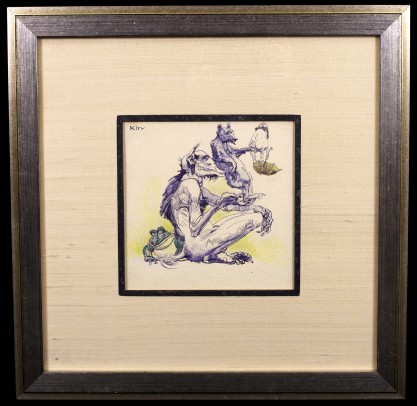

This dark and cleverly conceived and technically brilliant tinted pen & ink drawing with gouache highlights exemplifies the German expressionist artist Heinrich Kley’s brooding and satirical vision of mankind. At first take, we see a bear, ogre, and frog cavorting in a circus-like atmosphere, but on further reflection the scene turns darker. Kley’s pessimism about European man’s place on the cultural and evolutionary scale is expressed through this totem pole which shows the bear standing on the upheld palm of a demon (who has the whole world in the palm of his hand) who in turn supports the drooping buttocks of a human, seen with his back to the viewer. A limp umbrella dangles from the man’s hand in what is both a dirty joke and a highly symbolic take down of European notions of racial and cultural superiority. Aptly titled by the artist in German text “Skurrile Idee” which translates to “Bizarre Idea.”

Heinrich Kley is best remembered today for satirical, despairing, and often obscene images which evinced a maniacal distrust of the industrial revolution and its automatized society. In 1907, a series of remarkable pen & ink drawings appeared in the Munich German Expressionist literary art magazine Die Jugend that captured the growing disillusionment of fin-de-siecle German counter-culture. Kley’s scathing and deftly rendered creations resonated with audiences and Kley became a leading interpreter of the follies and vices that beset mankind. Kley’s art appeared in the United States in 1937 and caught the eye of Walt Disney & Sketch Artists at the Disney studio, including Albert Hurter, Joe Grant, and James Bodrero. Hurter introduced Kley’s work to the Disney Studio and Walt Disney accumulated a collection of the artist’s work. The images in Kley’s art inspired a number of animated sequences and characters, including Night on Bald Mountain and the dancing animals of Dance of the Hours in Fantasia.
In 1947 the “Drawings of Heinrich Kley” was published with a forward by George Grosz. Of Kley, Grosz wrote: “Kley used the pen like the lariat of a temperamental cowboy [and] is a great draftsman of animals. Like Walt Disney he humanizes the beasts […] I am sure that the drawings of Heinrich Kley will be remembered and enjoyed as long as human beings retain the ability to laugh at themselves.”
